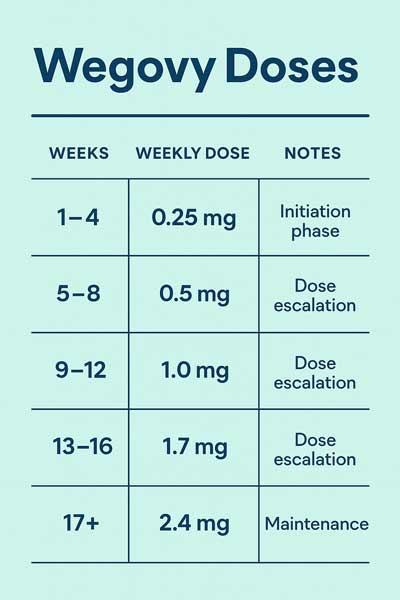
Weight management is increasingly becoming a cornerstone of modern aesthetic care. While cosmetic interventions can reshape, tighten, and rejuvenate, excess body fat often limits both the results and the longevity of those treatments. Wegovy® (semaglutide), a GLP-1 receptor agonist, offers an evidence-based, highly effective pharmacological tool for long-term weight management — one that can complement and enhance the services offered in cosmetic medical clinics.
For providers in the aesthetic space, understanding Wegovy dosing protocols is essential for ensuring patient safety, optimizing outcomes, and integrating this therapy seamlessly into your clinic’s treatment portfolio. This guide provides a detailed roadmap — from dosing timelines and patient selection to side effect management and business integration strategies.
Key Takeaways for Your Practice
- Gradual Titration: Stepwise dose increases over 16 weeks reduce gastrointestinal side effects and improve adherence.
- Maintenance Target: 2.4 mg weekly is the long-term dose for sustained weight loss and metabolic improvements.
- Aesthetic Synergy: Pre-procedure weight loss can improve surgical safety, enhance contouring results, and support skin health.
- Engagement Opportunity: Weight management programs increase patient retention and open new service pathways.
- Ongoing Monitoring: Follow-up visits support adherence, manage side effects, and help maintain results.
Table of Contents
What is Wegovy?
Wegovy® is the first GLP-1 receptor agonist specifically approved for chronic weight management in adults with obesity (BMI ≥30) or overweight (BMI ≥27) and at least one weight-related comorbidity. The once-weekly injectable is used in conjunction with a reduced-calorie diet and increased physical activity. In the STEP clinical trials, participants on Wegovy achieved an average weight loss of around 15% of body weight over 68 weeks — results rarely matched by other pharmacological agents.
Mechanism of Action
Semaglutide works by mimicking the gut hormone GLP-1, which regulates appetite and food intake. The key physiological effects include:
- Slowing gastric emptying, leading to earlier and longer satiety.
- Reducing hunger signals at the hypothalamic level.
- Enhancing glucose-dependent insulin secretion and reducing glucagon secretion.
For cosmetic providers, these effects translate into steady, sustained weight loss that can improve skin elasticity, surgical safety, and the proportionality of body contours.
Wegovy Dosing Schedule
The gradual titration of Wegovy is critical for minimizing side effects and maximizing patient tolerance.
| Weeks | Weekly Dose | Key Clinical Notes |
|---|---|---|
| 1–4 | 0.25 mg | Initiation phase; sets patient expectations and allows physiological adaptation. |
| 5–8 | 0.5 mg | Appetite suppression begins; emphasize hydration and dietary modifications. |
| 9–12 | 1.0 mg | Weight loss becomes more visible; suitable time to introduce complementary cosmetic services. |
| 13–16 | 1.7 mg | Approaching full dose; reassess goals and tolerability. |
| 17+ | 2.4 mg | Maintenance phase; schedule periodic check-ins to support adherence and prevent relapse. |
Dose Adjustments and Clinical Considerations
- For patients with persistent side effects, hold at the current dose for an additional 4 weeks before increasing.
- If symptoms remain problematic, reduce to the previous dose level temporarily.
- Missed doses for >2 weeks may require re-titration from a lower step.
- Contraindicated in patients with a history of medullary thyroid carcinoma or MEN2.
Combining Wegovy with Cosmetic Treatments
Integrating Wegovy into your aesthetic care pathways can produce measurable benefits:
- Pre-procedure optimization: Achieving a healthier BMI can improve anesthesia safety and surgical outcomes for liposuction, abdominoplasty, and breast procedures.
- Post-procedure maintenance: Preventing weight regain helps preserve results from body contouring treatments.
- Non-surgical synergy: Pairing Wegovy with RF skin tightening or cellulite treatments can enhance visible improvements.
- Wellness branding: Position your clinic as a comprehensive transformation center, offering both internal and external rejuvenation.
Managing Side Effects
Common side effects include nausea, vomiting, diarrhea, constipation, and abdominal discomfort. Proactive counseling is key:
- Advise small, low-fat meals and avoidance of overeating.
- Encourage adequate hydration, especially if the patient is undergoing other treatments.
- Consider antiemetic support in the early titration phase if needed.
- Schedule follow-ups at dose escalation points to troubleshoot promptly.
Ideal Patient Profiles
In a cosmetic medical setting, ideal candidates often include:
- Patients preparing for body contouring or skin tightening who need weight reduction.
- Those with a history of weight cycling who want structured medical support.
- Patients seeking facial rejuvenation where weight loss could enhance facial proportions.
- Post-bariatric patients aiming to manage residual weight.
Case Examples in Cosmetic Settings
- Case 1: A 45-year-old woman scheduled for abdominoplasty lost 12% of her body weight with Wegovy over 5 months, reducing surgical time and improving contouring precision.
- Case 2: A 38-year-old man undergoing RF body sculpting paired Wegovy with dietary counseling, achieving enhanced muscle definition and reduced treatment sessions.

Implementation and Business Integration Tips
- Create a bundled “Aesthetic Weight Management” package including Wegovy, nutritional coaching, and body contouring services.
- Train staff to identify eligible patients during cosmetic consultations.
- Use your EHR or CRM recall system to track dose schedules and prompt follow-up appointments.
- Consider before-and-after photography to demonstrate combined aesthetic and weight loss results.
Conclusion
For cosmetic medical practices, Wegovy offers more than weight reduction — it provides a pathway to optimized procedure outcomes, stronger patient relationships, and expanded revenue streams. By understanding the dosing schedule, managing side effects, and integrating therapy into aesthetic care plans, clinics can deliver transformations that are both seen and felt.

About the Author: Doris Dickson is a specialist writer for Health Supplies Plus, focusing on the aesthetic medicine industry. She diligently researches cosmetic treatments and products to provide clear, concise information relevant to licensed medical professionals. Her work supports Health Supplies Plus’s commitment to being a reliable informational resource and trusted supplier for the aesthetic community.
Disclaimer: The content provided in this article is intended for informational purposes only and is directed towards licensed medical professionals. It is not intended to be a substitute for professional medical advice, diagnosis, or treatment, nor does it constitute an endorsement of any specific product or technique. Practitioners must rely on their own professional judgment, clinical experience, and knowledge of patient needs, and should always consult the full product prescribing information and relevant clinical guidelines before use. Health Supplies Plus does not provide medical advice.
